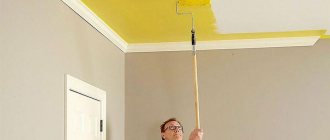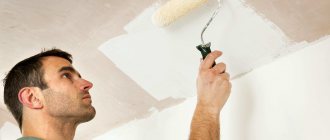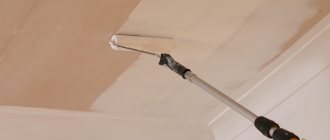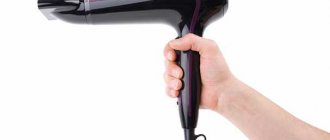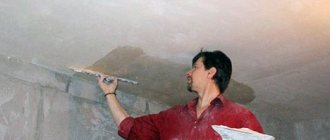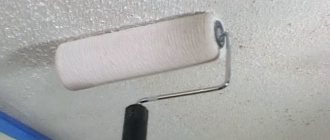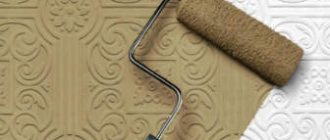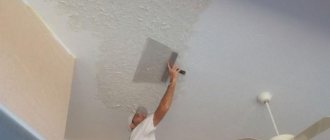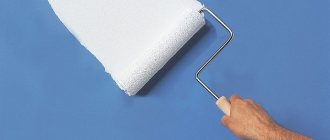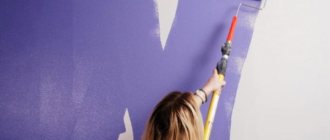Over time, dirty spots appear on the ceiling and walls painted with water-based paint. This is especially noticeable in the kitchen, where food is often prepared. Many housewives are interested in how to wash a ceiling painted with water-based paint in the kitchen so that this process goes quickly and efficiently.
Washing a ceiling painted with water-based paint.
The advantage of ceilings painted with water-based emulsion
Ceilings and walls treated with water-based paint have several advantages:
- This coating does not contain harmful components and even when the temperature in the living room increases, it does not emit harmful toxins.
- The water-based solution is easy to apply to the prepared surface of walls and ceilings.
- The surface painted in this way is resistant to high humidity.
- This paint will cost less than suspended ceilings, but it looks no worse.
- With minimal skills, staining can be done independently, without involving workers.
- A wide palette of water-based paint allows you to choose the color and tone to suit any interior.
- This paint can be used on ceiling tiles and is also used on multi-level surfaces.
The coating is resistant to high humidity conditions.
In other rooms, painted surfaces do not need to be washed frequently. But in the kitchen, the walls and ceiling get dirty faster and require special care. When choosing a water-based composition, preference should be given to those types to which acrylic or silicone is added.
Main types of paint
There are a number of dyes, each of which has certain advantages and disadvantages. Experts advise choosing formulations that can easily withstand washing. Thanks to this, it will be possible to maintain the cleanliness of the coatings and avoid constant repairs.
Silicate
This type of coating is considered the most resistant to moisture. In addition to the silicate base, the substances contain pigments and liquid glass. However, you should not use such compositions for painting bedrooms. An excellent solution for using silicate paint would be a bathroom. It is also allowed to apply it in other utility rooms and carry out external treatment.
Latex
These compositions fit perfectly on all types of bases and are easy to clean. The only disadvantage is the high cost, since this is an elite market segment.
Acrylic
This is one of the most popular coating options. This dye contains resins. They have a binding effect and make the paint more elastic. Some substances are characterized by resistance to moisture because they include a latex component.
Acrylic dyes are easily distributed over the surface and are durable. They usually have a pastel color scheme. To obtain a more saturated shade, special additives are added to the composition. Tinting is done in a store or at home.
Silicone
These coatings are based on silicone resins. They also include acrylic copolymers. The products protect surfaces from fungal microorganisms and mold. The compositions are characterized by vapor-proof properties.
What products can be used to clean water-based coatings?
If the ceiling is not very dirty, then you can wash it with a soap solution or liquid detergent and degreaser. A bar of laundry soap is crushed and dissolved in water until foam forms.
The simplest method is regular warm water with detergent.
As a soap component, you can also use a small amount of washing powder, shower gel or foam, or degreasing dishwashing liquid.
In order to wash oil, grease stains and soot that form directly above the stove, it is recommended to prepare a special cleaning solution.
You need to add 3 tbsp to 10 liters of warm water. l. baking soda and stir it thoroughly. Soda can be replaced with salt. The resulting composition is used to treat contaminated surfaces; after 15-20 minutes, the soda solution is washed off with clean water.
Removing stains
To wash a ceiling painted with water-based paint, use baking soda and warm water. The solution is prepared in stages:
- measure out 5 tablespoons of soda;
- add 5 liters of water to the container;
- mix thoroughly.
Cleaning stages:
- The surface is treated immediately after the soda particles have completely dissolved. The substance is suitable for removing even heavily soiled areas.
- The composition is left on the surface for at least 20 minutes.
- Then it is removed with a damp sponge.
- Contaminants will be removed along with the foam.
- If necessary, the procedure can be repeated several times.
It is not advisable to wet the ceiling too much. Excessive exposure will cause the paint to peel. Some people, wanting to wash a ceiling painted with water-based paint, replace soda with table salt. The substance has exactly the same effect. Apply the composition, rub a little with a sponge or damp cloth, and rinse thoroughly.
Preparing for general cleaning of ceilings
If you have started a general cleaning of the house, then before renewing the painted ceiling, it is recommended to remove dust on it using a vacuum cleaner. The brush head is pre-wrapped in a soft, dry cloth.
Means and materials for washing and cleaning the ceiling.
Gray carbon deposits above the stove and above the window frames are especially carefully removed. Then they get rid of the existing greasy stains and then proceed to wet cleaning the entire surface.
Old stubborn stains are removed carefully so as not to erase the paint layer.
If simple water-based paint was used for painting, it will be impossible to clean it from heavy contamination; it is better to repaint the surface again.
Safety precautions
When carrying out cleaning procedures, it is recommended to place the ladder as securely as possible. You should not install all kinds of pads under the legs if the floor is uneven. You cannot stretch while standing on a ladder in an attempt to cover the maximum area of the ceiling. In such a situation, it is recommended to get off and move the stepladder. Otherwise, there is a high risk of falling and serious injury.
Particular care is recommended when moving stairs if the floor is made of smooth tiles.
When wet cleaning the ceiling, water will fall onto the floor. On such a surface, the housewife may slip or the stepladder may move out of place.
See also
Which doors are best to choose for the bathroom and toilet?
The container for the soap solution must be of such size and shape that it is securely fixed on the landing of the stairs. It is recommended to wear an apron over your clothing. It should have roomy pockets. You can put a rag or sponge in them at each stage of cleansing. It often becomes necessary to wipe the ceiling with a dry cloth after cleaning with a damp sponge. In this case, the sponge can be placed in the apron pocket. Moreover, most likely, there is no place on the stairs for it. In addition, the sponge may fall, which means that you will have to go down to get it.
Mopping the ceiling
There are often traces left on the ceiling in the kitchen from gas combustion residues, from the evaporation of liquid during cooking, from flies and mosquitoes. To prevent it from becoming too dirty, it should be cleaned regularly. If you don’t have a stepladder, you can use a special mop with a long handle and a rotating mechanism.
First, treat the most contaminated surfaces with soda or saline solution. The soft cloth should then be rinsed thoroughly in clean water. After squeezing out excess water from a rag, wipe the entire ceiling; if necessary, the procedure can be repeated, replacing the dirty water with clean water.
If you use a cloth that is too damp, then unsightly stains may remain on the surface (especially if it is colored). After wet cleaning, the base is thoroughly wiped with a soft, dry cloth.
You can try to remove traces of mold using a special antifungal aerosol. If this does not help, then use copper sulfate, but after this the ceiling will have to be repainted.
Safe work
Cleaning the ceiling is difficult; this procedure requires special skill and takes a lot of time.
It is necessary to thoroughly wash each area so that dust and dirt are not visible in the future when the lights are on. This work requires compliance with safety regulations.
When washing the ceiling, you need to use a stepladder.
To easily reach a high ceiling, you should use a stable stepladder. It is desirable that it have a wide area for placing a container with soapy liquid.
Gloves are used to protect the skin of the hands from detergent components. To prevent cleaning solution and dust particles from getting into your eyes while working, you should wear safety glasses.
It is better not to use hard mops to avoid damaging the ceiling; it is better to use a soft cloth.
When washing, they grab small surfaces; you don’t have to reach far. It is better to rearrange the stepladder once again so as not to fall from it. It is advisable to have an assistant below who, if necessary, will provide the necessary items and provide backup.
Effective washing
To clean the ceiling effectively, you must use a soft, non-fading, lint-free cloth. Instead of fabric, you can use a foam sponge.
Wash the ceiling surface with a soft cloth.
Wipe the ceiling with gentle hand movements; you don’t need to press hard on it.
For surfaces painted with a water-based solution, do not use cleaning products that contain an abrasive substance, acid or other chemically active component.
You cannot use toxic solutions, the surface will be damaged, it will have to be renewed, and the room will need to be ventilated for a long time to remove the pungent odor.
Selection of materials and tools
This stage is considered the most important. The quality and service life of the future surface depend on the correct selection of tools and consumables.
It is important to make purchases in large chain hypermarkets or branded stores; there are a lot of fakes sold in the markets
Necessary tool
- The main painting tool used for working with water-based emulsion is a roller. To finish the ceiling, it is better to choose a product with a medium-wool coat - this way the paint will not splatter on the sides, but at the same time, the color of the base will overlap without spots or streaks. The height of the cylinder for faster operation should be 18–25 cm.
- Then you need to pick up one or two brushes for painting corners or hard-to-reach places, for example, behind ventilation ducts or pipes.
A brush no wider than 8 cm is best. You can also use an angled roller. You should buy a container for paint; it may be called a paint tray or tray, or a cuvette. The flat part of the bottom of the container should be corrugated so that it is convenient to squeeze out excess paint from the tool. Painting the ceiling with water-based paint does not require many tools. - In addition, you need to purchase fine-grain sandpaper, masking tape (ordinary tape will do) and plastic wrap. It is recommended to take care in advance of the availability of protective clothing, gloves, headgear and glasses. So that when painting the ceiling with water-based paint with your own hands you can control the quality of the surface, you need to prepare a powerful lamp and a pole to raise it to the ceiling.
- If you have a stepladder at hand, you can use it, but you should not purchase it specifically.
You can buy a telescopic tube for a roller or use tables, cabinets and other furniture as a stand. All small interior items should be removed from the room, and floors and bulky furniture should be covered with film. When painting the ceiling, it is more convenient to use trestles, as they are wider and more stable than a stepladder.
How to choose paint
To paint ceilings with water-based paint yourself, you can use the following types of material:
- Polyvinyl acetate compounds. The cheapest type of coatings. Surfaces coated with this paint should not be wetted with water.
- Latex. They are considered one of the highest quality. With their help you can obtain strong and durable coatings. The price of materials is also quite high.
- Acrylic. The most common type. They have a good combination of price and quality.
- Silicate. Compositions with the addition of liquid glass are most often used for painting stone or plastered surfaces. Can be used both indoors and outdoors.
- Silicone. They have good hiding power, vapor permeability and a long service life, but their high cost makes them less popular than acrylic paints.
Acrylic compositions are considered the most durable, PVA is the cheapest, for new buildings you need to take latex, universal acrylate ones are suitable everywhere, but they are expensive.
When choosing a material for painting, you need to listen to the advice of the seller, but it is also recommended to carefully read the label. The manufacturer indicates the following information on it:
- Type of work. This can be internal or external work on bases made of various materials.
- Paint consumption. Based on this indicator, you can approximately calculate the total amount of material, but it is better to add 10%.
- Covering power. The number of layers required to completely cover the old color depends on this indicator.
- Resistant to abrasion or moisture. The material may only be suitable for dry operating conditions in the absence of mechanical stress. A little more expensive are paints that can withstand mechanical stress. They are followed by materials that, after drying, do not dissolve with water, and the most expensive are dirt-repellent paints.
All water-based paints are white, color is added later, but the entire volume must be tinted, otherwise there will be stains
It is also important to consider the type of finished coating:
- Matte. They are difficult to clean, but visually increase the height of ceilings and mask minor defects.
- Glossy. More resistant to abrasion and easy to clean, but does not hide defects.
- Semi-matte. A compromise between the two above types.
We also suggest watching this video:
Working with walls
Before washing walls painted with moisture-resistant water-based paint, you should try the selected detergent on a small area of the surface.
This procedure will ensure that the coating does not collapse after cleaning.
Painted walls are washed more often than ceilings, especially when there are small children in the house. To wash the walls, you can use liquid soap, dishwashing liquid or floor cleaner. It is difficult to remove traces from markers made with alcohol; a thin layer of paint is easily damaged by vigorous rubbing with a rag.
How to protect yourself
Don't forget to be careful:
- You need to wash it piece by piece, without rushing.
- It is better to move the stepladder behind you, moving in small steps.
Often people lean back, trying to cover as much territory as possible with the rag, and as a result they fall. This may result in a little trouble and a few bruises if you have wood floors or carpet, but if you have tile, you could end up with serious injury.
Remember that general cleaning is a procedure that does not require such sacrifices, and take your time.
When emulsion and emulsion are different
For the production of water-based paints, several polymers with different properties are used. The most popular among them are:
- Silicate - forms a coating that allows the walls to “breathe”, but is not moisture-proof. Only wiping with a well-wrung out sponge or cloth is allowed.
- Latex has excellent steam permeability while retaining water. It can be washed without fear of disturbing the structure of the paint.
- Acrylic has better properties than silicate, but is in many ways inferior to latex. If exposure to moisture is short, it is quite capable of withstanding washing.
- Silicone is the best polymer today, which is not at all afraid of contact with water and is suitable for frequent washing.
Conclusion
After reading this review, you are convinced that cleaning the ceiling from soot is not so difficult. The main thing is to choose the right technology and means and work carefully so as not to damage the surface. The video in this article will tell you additional information on the topic, and if you don’t understand something, write questions in the comments.
Did you like the article? Subscribe to our Yandex.Zen channel
December 1, 2016
Operations with ceilings, Ceilings, Ceiling structures
If you want to express gratitude, add a clarification or objection, or ask the author something, add a comment or say thank you!
What is recommended to use for washing
Before cleaning a painted ceiling, you should decide what kind of dye it was coated with. The easiest way is to wash the ceiling with ordinary water. This can be done with a rag. A soft sponge is also suitable for this. This technique helps remove dirt and dust from the surface. It can be used in premises for various purposes.
It is worth considering that it will not be possible to remove grease and soot from the kitchen ceiling with ordinary water. In addition, before washing the painted surface, it is recommended to take into account that not all types of water-based paint can withstand strong friction. It will not be possible to remove greasy stains from a surface painted with the usual type of water-based paint without adding silicone or acrylic particles. Such dirt gets into the deep layers of paint. In this situation, you will have to completely update the ceiling.
Should I wash it off or not?
Do I need to remove water-based paint from the ceiling before painting? There is no clear answer to the question of whether it is necessary to wash off old water-based paint. It all depends on the specific situation you are in. Specifically, what color will the new paint be, is it very different from the one with which the surface was painted, what condition is the old paint in, and what is the quality of the surface on which the work will be done.
Important! The paint looks best on a flat surface where there are no potholes or similar defects, since the water-based emulsion is applied in a thin, even layer, it will be very difficult to hide old defects with its help. In this case, it is necessary to remove the old layer of paint.
Also, before repainting the surface, it is necessary to putty and prime the desired surface, especially the ceiling.
Secondly, if the old and new paints have a big difference in color, they should not be combined either. If the color of the paint that is already covering the surface is darker than the one you are going to apply, it will show through the lighter shade, no matter how hard you try to hide it. The number of layers does not matter here; the old paint will still be visible. Therefore, in order to avoid discrepancies in color and unnecessary work, in this case it is also worth removing a layer of old paint.
Thirdly, if the old paint is in unsatisfactory condition: it is peeling, swollen or has changed color in some places, it also needs to be removed. The reasons are obvious, but still: such work will have no appearance at all, and it is also possible that during the painting process it will continue to peel off.
But in other cases, that is, if the layer of old paint is in good condition and its shade matches the shade of the one you want to apply, you can leave it and paint over it.
Advice. In order for the paint to adhere well, you just need to wash it first, coat it with a primer and dry it, avoiding drafts.
